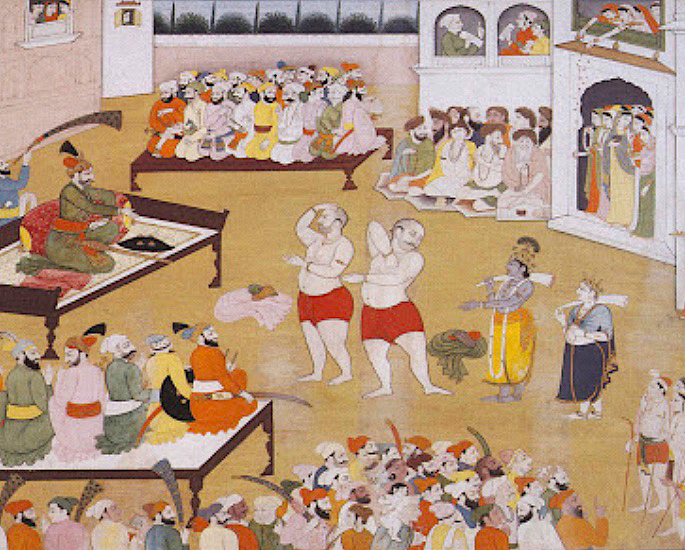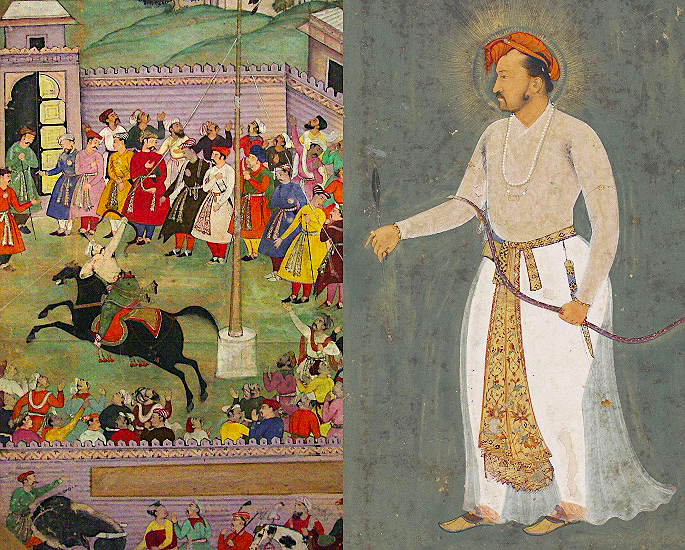"Duty is in my right hand and the fruits of victory in my left.”
Popular sports in India have an undeniable place in history, producing some fantastic talent and all-round display.
All these sports in India have a historical or cultural significance. Some of these sports even go back as far as the ancient times.
The British Raj also had an impact on popularising sports such as cricket and others over time.
Post partition, many popular sports in India had become part of everyday life, particularly with the advent of broadcasting. Exposure saw the emergence of extraordinary sports people.
India has also gone on to host many big tournaments and multi-sport events. This has had a major boost in the development of future stars.
We briefly, chronicle sports in India, especially when and how they came about as well as the significance of them.

HISTORICAL PERSPECTIVE
Ancient History
According to history books, some sports in India trace their roots further back than even monotheistic faiths.
Sports in India date back as far as 8000 years, deriving from the Bronze Age. Records suggest the birth of sports in India came during the Indus Valley Civilisation, 3300-1300 BCE (Before Common Era).
The Indus Valley Civilisation was primarily covering the north-western region of South Asia.
The area is famous for its advance civilisation. The inhabitants have necessary urban awareness and progressive political processes.
The Indus Valley also had complex sewage drainage systems, buildings for domestic and non-residential use, along with essential water supply networks.
So it stands to reason why a sophisticated society would gravitate towards social activities like sports.
Even a mantra in the Atharvaveda sums up the importance of sports: “Duty is in my right hand and the fruits of victory in my left.”
During the Vedic era (late Bronze Age) some sport became more widespread but were only for the rich and distinguished.
Some sports are unequivocally known to have their roots from India.

Chess or ‘Chaturanga’
Historians have unearthed evidence of early versions of chess (chaturanga) and primitive styles of dice games.
The creation of chess came during the Gupta Dynasty (280 Ad – 550 AD). Chaturanga was the predecessor of chess.
Chaturanga was split into four elements, each representing one division of the military. This includes the infantry, cavalry, elephants and charriority.
It also became a popular mental game, which made its way to Persia. The Persian empire went onto adapt this into a game with pawns, rooks, bishops, knights, queen and a king.
Wrestling or ‘Pehlwani’
Pehlwani is a form of wrestling originating in India, during the Mughal Empire (1500-1800 AD).
Referring also as Malla-yuddha, it became a spiritual practice. Athletes training for Malla-yuddha were living in dorms, practising vegetarianism and coaching other students.
Main focus points of the sport taught grappling, biting, choking and pressure point striking.
Malla-yuddha was one of the major influences on mixed martial arts.

Polo
The ancient signs of Polo came when Turkic slave Qutbuddin Aibak was the Sultan of Delhi, ruling between 1206-1210.
He apparently met his death during a polo match in Lahore. The sport also being known as Chaugan was very popular during the Mughal period.
The early origins of the game also trace to Manipur. It particularly has a link to Sangkol Kangjei, a form of hockey played in Manipur.
Imphal Polo field in Manipur state is one of the oldest ground in the world.
Kabaddi
Kabaddi has its roots in India and Iran. Sports historians have a difference of opinion when pinpointing one specific historical origin for this sport.
However, an ancient version about the rules of kabaddi does find a place in the book
It reveals a story of the protagonist Arjuna who uses kabaddi as a way to fight his enemies. This is while protecting himself from any harm.

Other Sports
Other sports which became popular during certain periods include archery, swimming, hunting, and weightlifting.
Many of these sports were not bound with hard fix rules. They were played in a very anciently fashion without any impact from other parts of the world.
These games were not “modernised: until later. This is when countries became more connected.
BRITISH INDIA
East India Company and British Raj
The East India company notoriously sunk its claws into Indian soil during the sixteenth century. It also played a vital role in importing and exporting “exotic” goods between the two countries.
It was only later that it began branching out internationally. The East India Company is one of the contributing syndicates in the colonisation of India.
A revolt was imminent, and in 1857 a mutiny transpired in Meerut. This is after the East India Company increased land taxes and forced British social reforms for Indian people.
The rebellion was strong but ultimately unsuccessful. It weakened the company, which could no longer survive on its own.
A new system of governance was introduced. Thus, India became part of the British Crown in 1858.
Popular sports in India wavered under these circumstances.

Cricket
In 1721, British soldiers docked and decided to play cricket. They started playing with the locals on the seaboard of India, near Cambay.
Cricket became one of the first sports introduced to India. It instantaneously became a national favourite.
The first association was the Calcutta Cricket Club, establishing in 1792. In 1948, it was the Indian Parsi community who had a big hand in accepting cricket early on.
In 1898, Sir Ranjitsinhji Vibhaji Jadeja aka Ranji, a prince of Nawan Nagar was the first to float the idea of constructing an “Indian Team.”
Bowler Balwankar Baloo was India’s first great cricket player. In 1911, Maharaja Bhupinder Singh from Patiala was the captain of team India at the age of nineteen.
C.K. Nayudu, Prof. DB Deodhar, Wazir Ali, JG Navale, and Colonel Mistry were the other big names from this team.
Only the elite divulged in the gentleman’s game of cricket initially. However, it also slowly seeped into the streets of India, uniting the country and becoming injected into its blood.
In an interview with Quartz India, writer Shashi Tharoor accepts that the game of cricket, came to India, courtesy of the British:
“Yes, the British brought it to us.”
“But they did not do so in the expectation that we would defeat them one day at their own game.”
Mihir Bose is also the writer of the award-winning book, The History of Indian Cricket (1990).

Polo
The late 19th century saw the rise in modern polo, also known to some as ‘pulu.’ Silchar, Assam became home to the first polo club in India in 1834.
In 1862, the first polo club was founded by British tea planters, This is after discovering the game being played by local Indians in the 1850s.
During the same year, the old Calcutta Polo Club came into existence. British soldiers Sherer and Captain Robert Stewart were the founders of this club.
Gathering traction, the sport also travelled to the heights of England in 1872.
Additionally, in 1892, the Indian Polo Association was founded. From then on polo clubs across different parts of India were frequently holding events.
Badminton
The origins of Badminton derive from England. However, with India being part of the British empire, it was ultimately played by officers stationed in the city of Poona during the 1860s.
British officers were primarily playing the sport in the outdoors for some fun and enjoyment.
During those days, it was familiar as “battledore and shuttlecock.” This earlier version was different from the modern game in that the winner had to keep the shuttlecock in the air for the longest.
From then on the game evolved and developed as badminton in India.

Football
British soldiers had a major contribution in introducing football during the mid-nineteenth century.
Following matches between the teams of the armed forces, clubs were established throughout India.
In 1889, the first football club was formed. Mohun Bagan Athletic Club in Kolkata was developed thirty-two years after the first football team was established in England.
The club rapidly grew in popularity. The club’s first major trophy win was in 1904. Seven years later, in 1911, Mohun Bagan won its first major title, the Indian Football Association (IFA) shield.
Mohun beat East Yorkshire Regiment 2-1, to register a very famous win before independence.
The Indian Football Association was founded earlier in 1893, featuring only foreigners on the board until 1930.
The All India Football Federation (AIFF) took over in 1937, establishing itself as the main governing body.
However, they had to wait ten years, before gaining affiliate recognition from the international governing body, FIFA.
Snooker
In 1875, snooker was born on Indian soil but conceived by an English man. It was a spin-off billiards or “blackball,” where a young officer bent some rules, creating the game.
The Billiards Snooker Federation of India (BSFI) suggest that Ooty was “the most credible birthplace for the game of Snooker” in 1881. The first game took place at this hill station.
Writing a letter in 1938, Ian Hamiton, a British officer that was working from Ooty between 1882-84, notes:
“I was in at Ootacamund in 1882-84 and there still must be some crowd left who can testify to the belief their current that Snooker owed its birth to Neville Chamberlain fertile brain.
“Could the game have existed in Ooty even before Chamberlain arrival just waiting for him to discover it and give it a new name? This is certainly a possibility.”
On February 2, 1886, a letter from Captain Sheldrick of Calcutta also contained details about snooker. Additionally, the letter references British Army officers that were playing snooker.

Tennis
The introduction of tennis came in the 1880s, courtesy of British Army and Civilian Officers. It soon gathered a fair bit of interest.
Tournaments were intriguing to watch, especially with the creation of the Punjab Lawn Tennis Championships, originating in Lahore just five years later.
With the passage of time, more events became the norm. This includes the 1887 Bengal Lawn Tennis Championships at Calcutta (Kolkata) and the 1910 All India Tennis Championships in Allahabad.
Early tennis players were good, particularly Sardar Nihal Singh.
He was the first Indian tennis player to feature on the grass courts of Wimbledon in 1908.
By 1921 India had already beaten major countries like France, Netherlands, Romania, Spain and Greece in the all-important international Davis Cup.
Ghaus Mohammad Khan was a significant figure when in 1939, he became the first Indian to reach the quarter-finals of Wimbledon.
Hockey
In the late 19th century, hockey became quite widespread in India, as a result of the British Empire.
People wanted titles, big championships, grand events and shiny rewards. The epitome for British Indian sport was winning Olympic medals.
In 1885, the first hockey club was established in Calcutta. Despite there being no national competitions, major events had taken place ten years later.
The 1895 Beighton Cup took place in Calcutta, with Bombay organising the 1895 Agha Khan tournament. The Hot Weather Lahore tournament also became very popular in the early twentieth century.
On November 5, 1925, saw the establishment of the India Hockey Federation (IHF).
Two years later, during 1927, IHF was successful in obtaining global membership from the International Hockey Federation (IHF).
In 1928, the Indian hockey team won its first gold medal at the Amsterdam Summer Olympics. They defeated Netherlands 3-0 in the final at the Olympisch Stadion on May 26, 1928.
The star for team India was Dhyan Chand, with two goals in the final and fourteen overall.
Other key players in this triumphant team included Feroze Khan, Shaukat Ali, Jaipal Singh and Sayed Mohamed Yusuf.
Under British influence, team India remained undefeated at the Summer Olympics until 1936.

POST PARTITION
Sports Development and Success
On August 15, 1947, India left the British crown, 347 years later after the English first stepped foot into this amazing country.
It was an uncertain time, no one knew how India was going to flourish on its own, and what type of identity it would embody.
But popular sports in India grew from strength to strength. Post partition India had many sporting successes.
The country went on to host many tournaments, along with producing many great athletes.
Hosting and Accomplishments at Major Sports Events
India has hosted many internationally distinguished events. After India gained independence, it was home to the Asian Games during March 1951 in Delhi. They won fifteen gold medals at these Games.
Thirty-one years later India was hosting the same multi-sport event in the same city during November-December 1982. Here they bagged thirteen gold medals.
India held the first Afro-Asian Games multi-sport event in Hyderabad-Secunderabad from October 24 to November 1, 2003. India managed to win nineteen medals at these Games.
Cricket, which is arguably the nations favourite sport, saw India jointly host World Cups in 1987, 1996 and 2011.
Mahendra Singh Dhoni led his team to victory on home turf, defeating Sri Lanka in the final by six wickets at the Wankhede Stadium in Mumbai on April 2, 2011.
Hockey was the other sport to host more than one world cup in India. The first world cup took place in Delhi from February 28 to March 13, 2010.
Eight years later, India also organised the 2018 Hockey World Cup in Bhubaneswar.

India went onto also host the 2010 Delhi Commonwealth Games for the first time in its history. The multi-sport event took place in the capital from October 3-14, 2010.
India finished second on the final table tally, with thirty-eight gold medals.
Some of the big names became gold medallists. These include Abhinav Bindra (shooting), Geeta Phogat (wrestling) and Saina Nehwal (Badminton).
The Gachibowli Stadium in Hyderabad played host to the 17th Badminton World Championships from August 10 to 16, 2020.
With Formula One racing being very popular, India held their first Grand Prix at the Buddh International Circuit in district Buddhnagar on October 30, 2011.
The Grand Prix also took place at the same venue for two more years in 2012 and 2103.
Achievements in India
The Indian football team was one one of the top 20 teams from Asia, winning the Asian Games in 1951, and 1962.
In 1951 they overcame Iran by one solitary goal. Whereas in 1962, they narrowly got the better of South Korea 2-1.
During both triumphs, former football player and coach Syed Abdul Rahim was instrumental with the team.
Whilst athletics had links to the British Raj, it did take time for the country to produce champions. Milkha Singh also familiar as the “Flying Sikh’ received a gold medal in the 400 metres at the 1962 Delhi Asian Games.
From a snooker point of view, Geet Sethi was victorious in the 1992 WPBSA World Championships, beating Mike Russell at Holiday Inn, Bombay. He repeated the same feat at home in 1993, 1995 and 1998.
In 2004, India won the first standard style Kabaddi World Cup. They comfortably registered a 55-27 victory over Iran during the final in Mumbai on November 21, 2004.
Subsequently, India also became Kabaddi World Cup champions at home in 2007 (Panvel) and 2016 (Ahmedabad).

Team India also lifted their first circle style Kabaddi World Cup in 2010. They comfortably demolished Pakistan 58-24 at the Guru Nanak Stadium, Ludhiana on April 12, 2010.
As hosts, India had dominated the Kabaddi World Cup, winning four more consecutive tournaments until 2016.
Boxing is another sport which began to flourish late in the country. Mary Kom is a name that needs no introduction.
She is the winner of six AIBA World Championships. Mary won her first World Championship gold medal at home in Delhi during 2006. She beat Steluta Duta (ROM) under the 46kg division.
Sachin Tendulkar is a name forever inscribed in the Indian sports Hall of Fame.
Despite achieving a lot in the game, he went onto fulfil his dream of winning the World Cup in 2011. India had earlier clinched the 1983 Cricket World Cup under the captaincy of all-rounder Kapil Dev.
Sports Leagues in India
There are many professional sports leagues in India, with some of them becoming very popular. The annual Indian Premier League (IPL) is the number one T20 franchise cricket tournament in India.
The Board of Cricket for Cricket in India (BCCI) founded the IPL during 2008. Former BCCI Vice-President, Lalit Modi was the visionary behind the IPL.
During the launch of the IPL, Modi said:
“The IPL has been designed to entice an entire new generation of sports fans into the grounds throughout the country.
“The dynamic Twenty20 format has been designed to attract a young fan base, which also includes women and children.”
The IPL has had over ten successful seasons. The league provides a platform for young homegrown talent and international players from around the world.

The Indian Super League (ISL) is a premier football league that runs from October to March every year. On October 13, 2013, the competition was founded, with the first edition beginning in 2014.
By the 2017-2018 season, the ISL managed to secure recognition from Asia’s governing body for the sport, Asian Football Confederation (AFC).
Similar to the IPL, ISL also launches young Indian players, providing them with an opportunity to learn from big stars from the football world.
The Pro Kabaddi League (KPL) is an annual professional competition that took inspiration from the IPL.
The first edition of the PKL was organised in 2014. PKL targets a kabaddi audience from a grassroots, rural and urban context.
Celebrities and business tycoons have taken ownership of many teams that associate themselves with the IPL, ISL and PKL.
Outside and Impactful in India
Besides the aforementioned historical highlights, Indian sports has also had many successes outside of the country.
In 1975, India were victors of the Hockey World Cup in Kuala Lumpur, Malaysia. Captain Ajit Pal and Aslam Sher Khan helped India to a historic 2-1 victory over arch-rivals Pakistan.
Prakash Padukone was the first Indian to win the All England Badminton Championships in 1980.
Pusarla Venkata Sindhu is a legend in the sport. The face of badminton, she was the first Indian to clinch a World Championships gold meal in Basel 2019. Saina Nehwal is the other big badminton player.

Leander Paes, Mahesh Bhupathi and Sania Mirza have had a pivotal role in popularising tennis in India. Between themselves, they have more than thirty-five grand slam titles.
Whilst golf also has historical origins dating to 1829, it remains a growing sport in India. Jeev Milkha Singh is a successful golfer who has had more than three European Tour wins.
His maiden title on the Tour came at the 2006 Volvo China Open, edging Gonzalo Fernandez-Castano (ESP) by one stroke.
The Olympic Games have a huge part to play in reinforcing love for sports in India.
Every four years Indian pride for sports grows stronger and stronger.
Abhinav Bindra claiming gold in the 10 metres air rifle shooting at the 2008 Beijing Olympics was a glorious moment for India.
Popular sports in India are dominant in the country, producing many of the best athletes and teams to compete at the world level.
Besides popular sports, traditional and regional games such as Gilli-Danda have a cultural significance in India.






























































